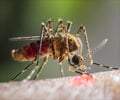
- Zika is a vector-borne tropical disease, which has led to recent outbreaks in several countries.
- Till date, there exists no cure or vaccine for the virus.
- A team of researchers have successfully genetic engineered a clone of the Zika virus.
- Cloning the virus may be a major step towards the development of a vaccine against the disease and for therapeutic purposes.
No Cure or Vaccine for Zika Virus
An alarming factor associated with this disease is the absence of a cure or a vaccine against the virus. Patients affected with this virus are treated symptomatically.New Study Brings Hope
This may not hold true for long, though, as a multidisciplinary team from Galveston, Texas has been successful in cloning the Zika virus, as revealed by a study published in the journal Cell Host & Microbe. The feat has been accomplished by a team of researchers at the University of Texas Medical Branch at Galveston. There are two strains of Zika virus- the Asian and the African lineage. The Asian lineage is found to be more virulent than the African and is responsible for the current outbreak of Zika.Infectivity of the New Clone
Cell Lines:The pfLZIKV RNA transcript was used to transfect vero cells to determine the infectious nature of the clone. Cytopathic effects were noticed in the transfected cells, displaying infectivity. Vero cells are cell lineages used in cell cultures.
Injection into Mice:
When the cloned DNA was injected into laboratory mice A129 (which lacked α/β interferon), there was weight loss on the first day and greater indication of virulence on the second and the third day.
Injection of the cloned DNA into mice with no αβ and γ interferons showed neurological symptoms.
Infection and Spread of Cloned Zika Virus
After this, the researchers used the cloned virus to infect artificial human blood and allowed Aedes aegypti mosquitoes to feed on it. After 14 days post feeding the mosquitoes were tested for the presence of the virus in their legs as well as bodies. The cloned virus showed greater infection and dissemination than the original virus. Apart from the infective ability demonstrated by the newly cloned virus, this experiment showed that A.aegypti was highly effective in transmitting this virus and spreading disease.Luciferase Signal and Use in Drug Discovery
The scientists included the Renilla luciferase gene into the cloned DNA as it can act as an indicator of growth. When this recombinant DNA was transfected into vero cells, luciferase signals were detected. This can be used to detect antiviral drug discovery, as the signals will be absent if the drug works on the transfected cells.Luciferase is the enzyme that causes fireflies to glow. This tracker can help in keeping a track of the virus when introduced into mosquitoes and even aid the screening of potential antivirals.
The Significance of Cloning Zika Virus
Zika virus is a Flavivirus and is closely related to viruses that cause dengue fever and West Nile fever. Zika was initially transmitted from one monkey to another through a mosquito bite. It made its first appearance in humans in 1952 in Uganda and remained limited to the African continent. In 2007, after the increase in travel and trade across the world, the virus resulted in outbreaks in countries outside Africa.The change in its severity, mutation and the unavailability of a drug or vaccine make this study a major breakthrough. The cloned virus is genetically similar to the strain that is currently prevalent in the United States of America.
- The virus has undergone mutation over the years which has made it more infectious for mosquitoes and thus results in a faster spread of the disease. This can be investigated by comparing the infectivity of the current strains with the old ones. The chikungunya virus is a mutation of the Zika virus.
- The evolution of the virus has resulted in higher concentration in the infected individual’s bloodstream and is, therefore, able to cross over to the fetus in the womb and causes birth defects.
- Understand the infectious nature of the disease
- Develop vaccines
- Identify effective anti-viral therapy
- Track viral replication invivo using luciferase reporter gene activity
References:
- Zika Virus Outside Africa
http://www.ncbi.nlm.nih.gov/pmc/articles/PMC2819875/ - Chao Shan, Xuping Xie, Antonio E. Muruato, Shannan L. Rossi, Christopher M. Roundy, Sasha R. Azar, Yujiao Yang, Robert B. Tesh, Nigel Bourne, Alan D. Barrett, Nikos Vasilakis, Scott C. Weaver, Pei-Yong Shi; “An Infectious cDNA Clone of Zika Virus to Study Viral Virulence, Mosquito Transmission, and Antiviral Inhibitors” http://dx.doi.org/10.1016/j.chom.2016.05.004











